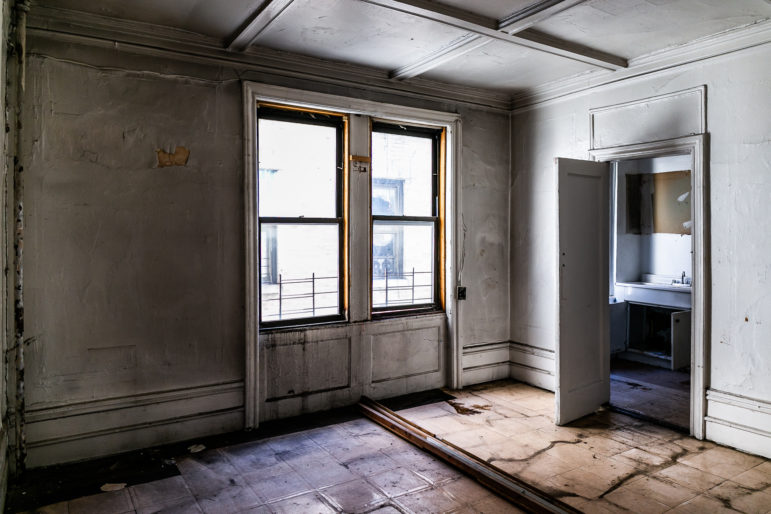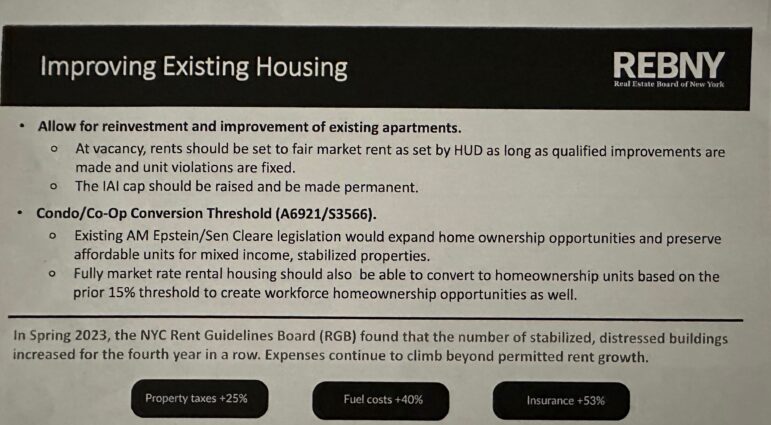As state lawmakers debate how best to address New York’s dual housing and homelessness crises, tenant advocates are keeping a wary eye on proposals they say would undermine landmark 2019 protections for renters in stabilized apartments.

Adi Talwar
A vacant rent-stabilized apartment in the Hamilton Heights neighborhood of Manhattan in 2022. Landlords say 2019 changes to the state’s rent laws have made it harder for them to afford making repairs to bring such units back online.As state lawmakers debate how best to address New York’s dual housing and homelessness crises, tenant advocates are keeping a wary eye on proposals they say would undermine landmark 2019 protections for renters in stabilized apartments.
Last year, Queens State Sen. Leroy Comrie and Bronx Assemblymember Kenny Burgos introduced legislation to increase rents on vacant regulated apartments following a tenancy of at least 10 years. Landlords cheered the bill, saying they need a rent boost in order to fix these units up.
Helping landlords bring apartments back onto the market during a housing crunch would be a “meaningful, quick solution to a very pressing problem” Burgos told City Limits Wednesday.
And while the bill has yet to gain broad traction—it has eight cosponsors in the Assembly and and 10 in the Senate—the powerful Real Estate Board of New York (REBNY) circulated similar policy proposals in January, in a “Housing Briefing” packet reviewed by City Limits.
Linda Rosenthal, chair of the Assembly Housing Committee, said Wednesday that she has noticed an increase in lobbying to boost rents on vacant apartments, a move she opposes. “This is an attempt to circumvent the rent stabilization laws, and we see it very clearly for what it is, and I am not going along with that,” she said.
In June 2019, New York passed the Housing Stability and Tenant Protection Act (HSTPA), multi-part legislation that eliminated most avenues for landlords of stabilized buildings to increase rents between tenancies.
Under rent stabilization, roughly 1 million households in New York City have a right to a lease renewal, and see limited annual rent adjustments.
Prior to the HSTPA, landlords could permanently lift units out of regulation after rents reached a certain threshold, an option known as vacancy decontrol. They could also increase rents 20 percent between tenancies, with additional increases to cover renovation costs.
Tenants celebrated the elimination of these allowances over four years ago, saying they cut out a major incentive to harass families out of their homes. But landlords argued that they could no longer afford to repair vacant apartments, and blamed the HSTPA for certain stabilized units being held off the market.
There were about 26,300 rent stabilized apartments both vacant and unavailable for rent in 2023, according to the latest Housing Vacancy Survey, down from 42,860 in 2021. Looking at a longer time horizon, the survey estimates that a smaller number of units—13,680, both regulated and not—have been vacant for 12 months or longer.
Whether landlords are holding some share of units offline by choice or out of necessity has been hotly debated in recent years.
Jay Martin is executive director of the Community Housing Improvement Program (CHIP), a trade organization for rent stabilized property owners in New York City that has been advocating for Comrie and Burgos’ bill, known as the Local Regulated Housing Restoration Adjustment (LRHRA), since early 2023.
In a recent interview, he described the legislation as a “win-win,” saying that it would not increase rents for current rent stabilized tenants and, upon vacancy, would cap rents “at reasonable amounts while allowing owners to be compensated for the extensive renovations they will need to do to get these units back online.”
According to the bill, new, higher rents would still be subject to regulation, and could not increase beyond annual Rent Guidelines Board allowances.
But tenant advocates have condemned the legislation. At Wednesday’s joint Senate and Assembly hearing on housing, Mike McKee, treasurer of Tenants PAC, described it as a “wolf in sheep’s clothing” that would “put a target on the back” of long-term tenants whose landlords would once again have a financial incentive to get them out.
A page in REBNY’s January housing policy packet titled “Improving Existing Housing” touches on similar themes, albeit with few details, stating that New York should “allow for reinvestment and improvement of existing apartments.”
It then zeroes in on vacant apartments: “At vacancy, rents should be set to fair market rent as set by HUD [U.S. Department of Housing and Urban Development] as long as qualified improvements are made and unit violations are fixed.”

Obtained by City Limits
A memo from a policy packet from the Real Estate Board of NYThe packet also calls for an increase to the Individual Apartment Improvement (IAI) cap, which limits how much landlords can increase rents to compensate for renovation costs.
Fair Market Rents, or FMRs, are annual federal estimates of rent and utility costs, based on the spread of rents in a given geographic area. They’re typically set at the 40th percentile, or the dollar amount above 40 percent of rents for “standard quality units” in the area, according to HUD.
The most recent FMR for the New York metropolitan region is $2,451 for a one-bedroom and $2,752 for a two-bedroom. HUD also produces small area FMRs, which come in above or below these standards depending on the zip code.
By contrast, the median monthly rent for rent-stabilized apartments in New York City in 2023 was $1,500, according to the latest Housing Vacancy Survey. Regulated or not, 74 percent of units had rents under $2,400.
Comrie and Burgos’ legislation states that the rent increase on a vacant apartment would not exceed local voucher payment standards, or the maximum subsidy amount a housing authority will pay on behalf of a voucher holder.
In New York City, those maximums are $2,696 for a one-bedroom and $3,027 for a two-bedroom. However, the New York City Housing Authority performs rent reasonableness tests, and can negotiate lower rents with landlords based on a review of comparable, unsubsidized apartments within a quarter mile of the unit in question.
“We’re working very hard to get this passed, and probably for the sake of the industry the best course would be for REBNY to support that legislation,” said Martin of CHIP.
Reached Tuesday, REBNY did not comment on the FMR proposal in its policy packet, or say whether it supports Comrie and Burgos’ bill, but said landlords need a route to renovate “dilapidated” apartments.
“As the State Legislature acknowledged last June, part of the answer to the city’s deepening housing crisis involves enabling owners to rehabilitate dilapidated rent regulated units so they can be put back on the market as quality affordable housing,” President James Whelan stated.
Whelan appeared to be referencing a press release from the end of last year’s legislative session, in which Assembly Speaker Carl Heastie and Senate Majority Leader Andrea Stewart-Cousins acknowledged that they had failed to reach a deal on housing policy.
In it, Heastie and Stewart-Cousins listed several priorities, including a “Dilapidated Apartment Repair Program” and “raising the individual apartment improvement cap.”
Ellen Davidson of the Legal Aid Society, who engages in her organization’s lobbying efforts in Albany, said she found the messaging from REBNY confusing.
“It’s not clear to me what REBNY’s proposal is,” she said. “Because they won’t say if they support the actual bill…so it’s not clear that it’s anything more than a talking point.”
But the rhetoric is nevertheless concerning, Davidson continued. According to the Community Service Society (a City Limits funder), data from the 2021 Housing Vacancy Survey showed 55 percent of rent stabilized households living in a unit that had been occupied since 2014, suggesting most exceeded the 10-year threshold in the LRHRA.
While discussions of fair market rents and voucher payment standards might not be immediately concerning to the general public, Davidson said, under the existing bill, “half the [stabilized] rental stock of the city would be under threat.”
During Wednesday’s hearing, State Sen. Brian Kavanagh, chair of his body’s housing committee, said he was not aware of any broader housing deal in the works including some sort of vacancy rent increase, alongside measures including a tax incentive for development. “There is not a bill that’s being cooked up that I’m aware of,” he said.
Cea Weaver, organizing director for the statewide tenant coalition Housing Justice for All, said advancing the existing CHIP-backed bill would draw protest from rent stabilized tenants in New York City as well as smaller cities around the state that recently adopted rent stabilization.
“If our legislature threatens to pass this bill, rent stabilized tenants in New York City, but also now Kingston and Newburgh, will rise up to protect their homes,” she said.
With additional reporting by Chris Janaro.
To reach the reporter behind this story, contact Emma@citylimits.org. To reach the editor, contact Jeanmarie@citylimits.org









One thought on “Simmering State Rent Increase Proposals Have Tenant Groups On Guard”
The photo above shows an apartment that clearly has been vacant since pre-2019. In fact, the warehousing problem all over the city has been an issue for decades. Take a walk across Harlem and other similar areas to see.